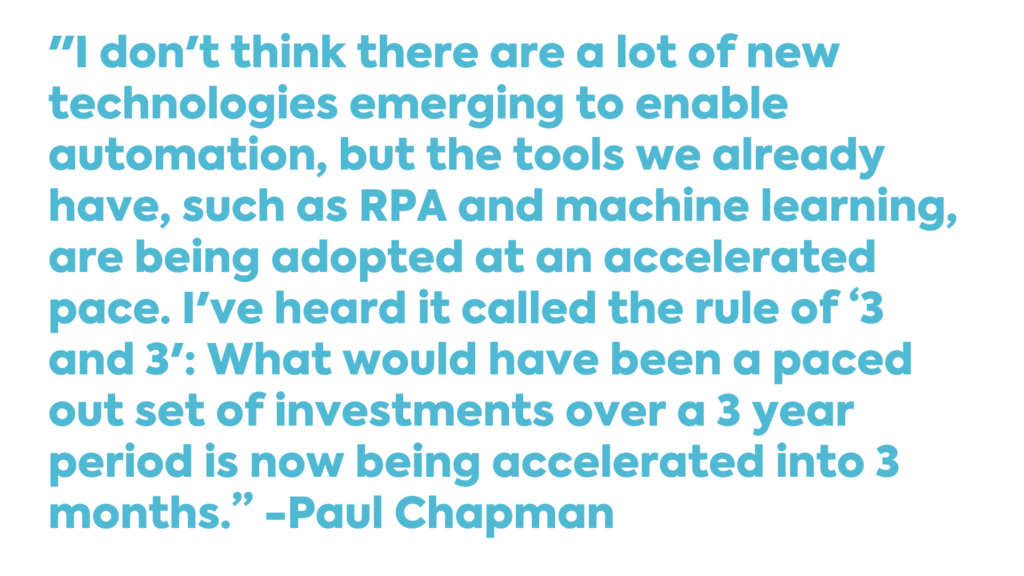

We are now living through an era of unprecedented change brought on by COVID-19, one that has impacted every enterprise across every industry.
What major effects have we seen, and how will the world look moving forward? For this spring’s CIO Insight Call, we were honored to be joined by Mark Campbell, Chief Innovation Officer at Trace3, and Paul Chapman, CIO and SVP for Box.com, who offered us their perspectives on the crisis and its aftermath.
In April, we surveyed roughly 100 leaders in the Mayfield Innovators Network about the impact COVID-19 has had on their business. Bottom line: Everyone has taken a revenue hit, some businesses are at risk of failing, and there’s no telling what the economy will look like when it does recover.
But one of the most hopeful things we heard was that the crisis could end up accelerating digitization efforts that have been underway for some time.
1. The workforce is now elastic
The biggest near-term priority for tech leaders in our survey was enabling an elastic workforce that can operate from anywhere. That’s why enterprises are accelerating their adoption of cloud-based collaboration platforms like Zoom, Office 365 and Box.

Once they’ve standardized on a single platform, they’ll eventually want to bring their supply chain, consultants, contractors, and even customers onto them. Telemedicine is the poster child for this, but the idea is starting to pop up across all segments.
Elasticity also means revisiting how employees, partners, and the community at large can securely access the network remotely. While the majority of enterprises still rely on VPNs for secure access, a growing number are looking at zero-trust networks and software-defined perimeters.
Because offices are designed to bring people together so they can collaborate, they’re a poor fit for social distancing. It’s not clear why anyone would return to these environments if they can no longer work closely with colleagues. That’s why a lot of companies will take a wait-and-see approach before bringing people back.
This will have serious implications for commercial real estate and recruitment. For example, if you operate a call center, having all your reps work remotely changes the mathematics quite a bit and may also reduce churn. You can recruit on a national scale and hold onto employees longer.

2. Some organizations will remain outliers
While the shift toward an elastic workforce will likely outlast the current crisis, extremes will continue to exist on either end. On one hand are the Mavericks – organizations that have 80 percent of their people working remotely and are thinking ‘What if we tried to hit 90 percent? How can we remove even more impediments to productivity?’
At the other extreme are Traditionalists, companies that plan to bring most of their workforce back. As one of Trace3’s customer noted, it’s very hard to build an aircraft wing over WebEx. But their marketing, finance, legal, or HR staff may continue to work remotely.
This dichotomy extends to IT budgets. Some industries, like streaming media, have gotten a boost from this crisis. Companies in other sectors may be going out of business. Even among that group, however, the Mavericks are investing in technology more heavily than ever. The Mavericks are saying, ‘If we’re doing down, we’re doing down swinging.’ They’re continuing to double-down on remote workforce tools, collaboration, and automation. They believe if they can pull that off while their competition is floundering, they’ll be eating like kings.

3. Tech leaders are becoming people officers
As people adopt new tools and new ways of working, tech leaders must pay more attention to the employee experience to make sure everyone is adapting to the new normal.
While working at home has led to productivity gains, executives will need to be more cognizant of mental fatigue and burnout from the blurring of work and home life. That’s why Box has built a wellness portal for employees, where they can set personal fitness goals and get health assessments. The company has increased its licensing for the Headspace app, which helps employees with sleep and wellness issues.

4. Digital marketing is ramping up
One area seeing increased investment during the crisis is digital sales and marketing. Many organizations are using this time to revisit their CRMs and predictive analytics capabilities. They’re also investing more heavily in remote-selling solutions, virtual event software, and ecommerce solutions. With attracting new customers right now is an uphill climb, enterprises are focusing on solidifying their existing relationships via custom, detailed messaging.

5. There are no more sacred cows
With the economy in free fall, every dollar becomes precious and shedding costs is a matter of survival. This will give a huge boost to automation. Manual workflows that were once considered sacrosanct – like operations, security, or business intelligence — are now fair game for automation. For example, call centers have begun deploying AI-based voice bots that are having surprisingly sophisticated conversations with customers.
At the time, many organizations are discovering that they’re not as automated as they thought they were. Like the company that still had a team faxing compliance forms to a state, even though the agency had an API they could hit. Even if you’ve automated internally, the other people up and downstream have to automate as well; otherwise you’ve just moved the bottleneck.

